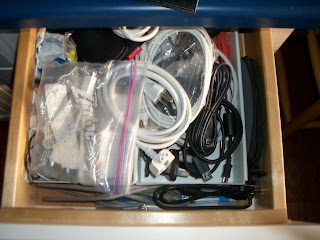The price of nuvi GPS units has dropped, so I got a second one for Jan's car. (Even women hate to ask directions, they just have the self-discipline to do it.) I know we could do this on a newer phone, but I've discovered having it on the windshield is much safer and easier.
Anyhoo, with the unit comes the inevitable cords, only one of which gets used much. So I carefully saved the other one in a drawer which has become strangely crowded:
If only, I mused they could develop a way of charging/connecting gadgets without cords. Well, Bluetooth and IR are helping with the information connections, and there may be hope on the power connection as well.
“From a semiconductor and power-management point of view, wireless charging is a natural extension of what we have been doing,” says Masoud Beheshti, director of battery-charge management at TI. He predicts that, like Bluetooth, wireless charging will initially be offered on high-end devices, before gradually becoming more widely available.
As wireless-charging equipment based on electromagnetic induction heads towards the market, a number of alternative technologies are also being developed to transmit power over both short and long distances. WildCharge, a start-up based in Colorado, has already started selling a number of wireless-charging devices that take a cheaper but simpler approach in which mobile devices make electrical contact with a special charging pad via four small conductive metal studs (pictured).
WildCharge and the licensees of its technology have developed replacement back covers for a number of popular devices, including Motorola’s RAZR phones and video-game controllers for the Nintendo Wii and the Sony PlayStation 3. No matter how the device is plonked down, two of the bumps establish direct electrical contact with the pad. The firm has also developed special “skins” for Blackberry smart-phones, so that they too can be charged without the need for an adaptor. Although it may not have the “wow” factor of inductive coupling, this approach does away with the necessity for a “handshake” between the device and the pad, and with the need to align the device and the pad in a particular way before charging can begin.
At the other end of the spectrum is the idea of long-range transmission of wireless power, which could in principle do away with the need for a charging pad altogether. This technique uses the energy in radio waves, broadcast from a transmitter and harnessed by an antenna, to generate electricity. Using the passive-power principle found in crystal radios, the method has proved successful over short distances in places where it is difficult to replace batteries or carry out maintenance. The problem is that the intensity of the radio waves needed to charge mobile phones and laptop computers over long distances might be hazardous to human health, and regulators would be unlikely to approve. [More]
Much the same way as cordless power tools have taken over the market, cordless gadgetry could be the next stimulus for needlessly replacing perfectly-operating devices. Remember, we now replace stuff due to feature inflation, not breakdowns.


No comments:
Post a Comment